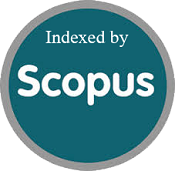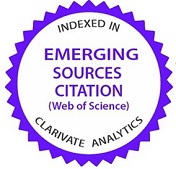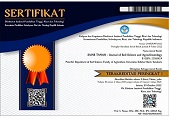Enhancing soil carbon stocks and soybean yields in coastal areas through the application of biofertilizers
Abstract
Climate change driven by increased concentration of greenhouse gases in the atmosphere has a significant impact on agricultural systems, particularly in coastal areas that are prone to rising salinity and decreased soil quality. The application of biofertilizers as a strategy for enhancing soil carbon stocks is crucial, given their role in promoting microbial activity and nutrient availability, leading to soil fertility. This study aimed to evaluate the role of biofertilizers in increasing soil carbon stocks and soybean yields in coastal areas. The research was conducted from April to December 2024 in Bengkulu City. The field experiment was designed in a split-plot design, with the main plot was soybean varieties at two levels (i.e., Anjasmoro and Dering I), and the subplot was fertilizer inputs at four levels (i.e., recommended inorganic fertilizer, AMF + Bradyrhizobium + potassium solvent, Bradyrhizobium + phosphate solvent + potassium solvent, and Bioenzyme). The application of biofertilizers and bioenzymes effectively increased soil carbon stock. The potassium-solubilizing microbial population had a greater influence on carbon stocks than the phosphate-solubilizing population and AMF. The use of biofertilizers and bioenzymes also improved soil biological properties and nutrient absorption, thereby contributing to increase soybean yields. This study provides evidence to support government policies promoting biofertilizer use in agriculture, including training and extension programs for farmers, particularly in coastal areas, to improve soil quality, enhance yields, and reduce dependence on chemical fertilizers which are often expensive and can degrade soil quality in the long term.
Keywords
Full Text:
PDFReferences
AbuQamar, S. F., El-Saadony, M. T., Saad, A. M., Desoky, E.-S. M., Elrys, A. S., El-Mageed, T. A. A., . . . El-Tarabily, K. A. (2024). Halotolerant plant growth-promoting rhizobacteria improve soil fertility and plant salinity tolerance for sustainable agriculture—A review. Plant Stress, 12, 100482. https://doi.org/10.1016/j.stress.2024.100482.
Akmalia, H. A. (2022). The impact of climate change on agriculture in Indonesia and its strategies: A systematic review. AGRITEPA: Jurnal Ilmu dan Teknologi Pertanian, 9(1), 145-160. https://doi.org/10.37676/agritepa.v9i1.1691.
Alamzeb, M., Asif, I., Inamullah, Mazhar, I., & and Ullah, I. (2024). Integrated use of phosphorus sources, phosphate solubilizing bacteria, and rhizobium enhanced growth, nitrogen, and phosphorus uptake in chickpea. Journal of Plant Nutrition, 47(17), 2913-2929. https://doi.org/10.1080/01904167.2024.2369086.
Ariani, M., Haryono, E., & Hanudin, E. (2021). Greenhouse Gas Emission from Rice field in Indonesia: Challenge for future research and development [GHG emission; rice field; Indonesia; future research]. 2021, 53(1), 14. https://doi.org/10.22146/ijg.55681.
Barbosa, J. Z., Hungria, M., Sena, J. V. d. S., Poggere, G., dos Reis, A. R., & Corrêa, R. S. (2021). Meta-analysis reveals benefits of co-inoculation of soybean with Azospirillum brasilense and Bradyrhizobium spp. in Brazil. Applied Soil Ecology, 163, 103913. https://doi.org/10.1016/j.apsoil.2021.103913.
Bertham, Y., Nusantara, A., Andani, A., Anandyawati, A., & Herman, W. (2020). The improvement of coastal soil fertility using soil conditioner from biocompost inoculated with phosphate-solubilizing microbes, Bradyrhizobium and arbuscular mycorrhizal fungi to increase soybean production. International Journal of Agricultural Technology, 16(3), 575–588. https://www.cabidigitallibrary.org/doi/full/10.5555/20203437663.
Bertham, Y. H., Arifin, Z., & Nusantara, A. D. (2019). The Improvement of Yield and Quality of Soybeans in a Coastal Area Using Low Input Technology Based on Biofertilizers. International Journal on Advanced Science, Engineering and Information Technology, 9(3), 787-791. https://doi.org/10.18517/ijaseit.9.3.6247.
Buragohain, P., Nath, D. J., & Phonglosa, A. (2019). Role of microbes on carbon sequestration. International Journal of Microbiology Research, 11(1), 1464-1468. https://bioinfopublication.org/pages/article.php?id=BIA0004775.
Burak, K., Yanardağ, İ. H., Gómez-López, M. D., Faz, Á., Yalçin, H., Sakin, E., . . . Yanardağ, A. (2024). The effect of arbuscular mycorrhizal fungi on biological activity and biochemical properties of soil under vetch growing conditions in calcareous soils. Heliyon, 10(3). https://doi.org/10.1016/j.heliyon.2024.e24820.
Chataut, G., Bhatta, B., Joshi, D., Subedi, K., & Kafle, K. (2023). Greenhouse gases emission from agricultural soil: A review. Journal of Agriculture and Food Research, 11, 100533. https://doi.org/10.1016/j.jafr.2023.100533.
Chaudhary, P., Singh, S., Chaudhary, A., Sharma, A., & Kumar, G. (2022). Overview of biofertilizers in crop production and stress management for sustainable agriculture [Review]. Frontiers in Plant Science, 13. https://doi.org/10.3389/fpls.2022.930340.
Chi, Z., Wang, W., Li, H., Wu, H., & Yan, B. (2021). Soil organic matter and salinity as critical factors affecting the bacterial community and function of Phragmites australis dominated riparian and coastal wetlands. Science of The Total Environment, 762, 143156. https://doi.org/10.1016/j.scitotenv.2020.143156.
Cui, Y., Moorhead, D. L., Peng, S., & Sinsabaugh, R. L. (2023). New insights into the patterns of ecoenzymatic stoichiometry in soil and sediment. Soil Biology and Biochemistry, 177, 108910. https://doi.org/10.1016/j.soilbio.2022.108910.
Dhingra, A., Shinde, S., D’Agostino, L., Devkar, V., Shinde, H., Rajurkar, A. B., . . . Patil, G. B. (2024). Identification of novel germplasm and genetic loci for enhancing mineral element uptake in soybean. Environmental and Experimental Botany, 219, 105643. https://doi.org/10.1016/j.envexpbot.2023.105643.
Ding, B., Cao, H., Bai, Y., Guo, S., Zhang, J., He, Z., . . . Liu, H. (2024). Effect of biofertilizer addition on soil physicochemical properties, biological properties, and cotton yield under water irrigation with different salinity levels in Xinjiang, China. Field Crops Research, 308, 109300. https://doi.org/10.1016/j.fcr.2024.109300.
Don, A., Seidel, F., Leifeld, J., Kätterer, T., Martin, M., Pellerin, S., . . . Chenu, C. (2024). Carbon sequestration in soils and climate change mitigation—Definitions and pitfalls. Global Change Biology, 30(1), e16983. https://doi.org/10.1111/gcb.16983.
Dullah, I. C., Sulandjari, S., & Supriyono, S. (2019). Abiotic Stress and Biofertilizer on The Pereskia bleo (Kunth) DC. Against Growth, Proline, and Antioxidants. Sains Tanah Journal of Soil Science and Agroclimatology, 16(1), 10. https://doi.org/10.20961/stjssa.v16i1.25158.
El-Egami, H. M., Hegab, R. H., Montaser, H., El-Hawary, M. M., & Hasanuzzaman, M. (2024). Impact of Potassium-Solubilizing Microorganisms with Potassium Sources on the Growth, Physiology, and Productivity of Wheat Crop under Salt-Affected Soil Conditions. Agronomy, 14(3), 423. https://doi.org/10.3390/agronomy14030423.
Faé, G. S., Kemanian, A. R., Roth, G. W., White, C., & Watson, J. E. (2020). Soybean yield in relation to environmental and soil properties. European Journal of Agronomy, 118, 126070. https://doi.org/10.1016/j.eja.2020.126070.
Ferayanti, F., Idawanni, Ismail, M., Asis, Pakpahan, L. E., Andriani, R., . . . Syarif, A. S. (2020). Growth and results response of two soybean varieties toward fertilizing package at acid dry land in Aceh Province. IOP Conference Series: Earth and Environmental Science, 484(1), 012080. https://doi.org/10.1088/1755-1315/484/1/012080.
Guo, J., Hu, S., & Guan, Y. (2022). Regime shifts of the wet and dry seasons in the tropics under global warming. Environmental Research Letters, 17(10), 104028. https://doi.org/10.1088/1748-9326/ac9328.
Hawkins, H.-J., Cargill, R. I. M., Van Nuland, M. E., Hagen, S. C., Field, K. J., Sheldrake, M., . . . Kiers, E. T. (2023). Mycorrhizal mycelium as a global carbon pool. Current Biology, 33(11), R560-R573. https://doi.org/10.1016/j.cub.2023.02.027.
Jabin PP, N., & Ismail, S. (2023). Effect of different potassium solubilizing microbial inoculants on chemical properties of soil. The Pharma Innovation Journal, 12(7S), 407-412. https://www.thepharmajournal.com/special-issue?year=2023&vol=12&issue=7S&ArticleId=21342.
Just, B. S., Netherton, M. E. A., Laura, R.-B., Laia, L., Sergio, P., & and Vilaplana, R. (2024). Biofertilization increases soil organic carbon concentrations: results of a meta-analysis. International Journal of Agricultural Sustainability, 22(1), 2361578. https://doi.org/10.1080/14735903.2024.2361578.
Keutgen, A. J. (2023). Climate change: challenges and limitations in agriculture. IOP Conference Series: Earth and Environmental Science, 1183(1), 012069. https://doi.org/10.1088/1755-1315/1183/1/012069.
Khan, M. N. I., Rahman, A., Nahid, G. A. R., Hasan, M. A., Islam, M. R., Azad, M. S., & Mollick, A. S. (2023). Stand level carbon stocks in the soil-vegetation system of the coastal mangrove plantations in Bangladesh: Effect of stand age and choice of species. Regional Studies in Marine Science, 63, 103029. https://doi.org/10.1016/j.rsma.2023.103029.
Kuila, D., & Ghosh, S. (2022). Aspects, problems and utilization of Arbuscular Mycorrhizal (AM) application as bio-fertilizer in sustainable agriculture. Current Research in Microbial Sciences, 3, 100107. https://doi.org/10.1016/j.crmicr.2022.100107.
Kumar, A., Saharan, B. S., Parshad, J., Gera, R., Choudhary, J., & Yadav, R. (2024). Revolutionizing Indian agriculture: the imperative of advanced biofertilizer technologies for sustainability. Discover Agriculture, 2(1), 24. https://doi.org/10.1007/s44279-024-00037-y.
Kumawat, A., Kumar, D., Shivay, Y. S., Bhatia, A., Rashmi, I., Yadav, D., & Kumar, A. (2023). Long-term impact of biofertilization on soil health and nutritional quality of organic basmati rice in a typic ustchrept soil of India [Original Research]. Frontiers in Environmental Science, 11. https://doi.org/10.3389/fenvs.2023.1031844.
Ladha, J. K., Peoples, M. B., Reddy, P. M., Biswas, J. C., Bennett, A., Jat, M. L., & Krupnik, T. J. (2022). Biological nitrogen fixation and prospects for ecological intensification in cereal-based cropping systems. Field Crops Research, 283, 108541. https://doi.org/10.1016/j.fcr.2022.108541.
Li, J., Li, W., Feng, X., Liu, X., Guo, K., Fan, F., . . . Jia, S. (2024). Soil Organic Matter Input Promotes Coastal Topsoil Desalinization by Altering the Salt Distribution in the Soil Profile. Agronomy, 14(5), 942. https://doi.org/10.3390/agronomy14050942.
Liu, Y., Xun, W., Chen, L., Xu, Z., Zhang, N., Feng, H., . . . Zhang, R. (2022). Rhizosphere microbes enhance plant salt tolerance: Toward crop production in saline soil. Computational and Structural Biotechnology Journal, 20, 6543-6551. https://doi.org/10.1016/j.csbj.2022.11.046.
Mahmud, A. A., Upadhyay, S. K., Srivastava, A. K., & Bhojiya, A. A. (2021). Biofertilizers: A Nexus between soil fertility and crop productivity under abiotic stress. Current Research in Environmental Sustainability, 3, 100063. https://doi.org/10.1016/j.crsust.2021.100063.
Mason, A. R. G., Salomon, M. J., Lowe, A. J., & Cavagnaro, T. R. (2023). Microbial solutions to soil carbon sequestration. Journal of Cleaner Production, 417, 137993. https://doi.org/10.1016/j.jclepro.2023.137993.
Minasny, B., Malone, B. P., McBratney, A. B., Angers, D. A., Arrouays, D., Chambers, A., . . . Winowiecki, L. (2017). Soil carbon 4 per mille. Geoderma, 292, 59-86. https://doi.org/10.1016/j.geoderma.2017.01.002.
Mishra, P., Mishra, J., & Arora, N. K. (2021). Plant growth promoting bacteria for combating salinity stress in plants – Recent developments and prospects: A review. Microbiological Research, 252, 126861. https://doi.org/10.1016/j.micres.2021.126861.
Mitchell, E., Naoya, T., Liam, G., Peter, G., Ken, D., Sahar, A., . . . and Rowlings, D. (2024). Making soil carbon credits work for climate change mitigation. Carbon Management, 15(1), 2430780. https://doi.org/10.1080/17583004.2024.2430780.
Narayan, H., Kumar, U., Chowdhury, T., Swain, P., Barik, M., & Nayak, A. K. (2024). Effect of salinity stress on growth, chlorophyll, antioxidant enzymes and nutrient content in Azolla spp. Aquatic Botany, 192, 103750. https://doi.org/10.1016/j.aquabot.2024.103750.
Ortas, I. (2022). The role of mycorrhiza in food security and the challenge of climate change. International Journal of Agricultural and Applied Sciences, 3(1), 1-11. https://doi.org/10.52804/ijaas2022.311.
Pacioni, G. (1992). 16 Wet-sieving and Decanting Techniques for the Extraction of Spores of Vesicular-arbuscular Fungi. In J. R. Norris, D. J. Read, & A. K. Varma (Eds.), Methods in Microbiology (Vol. 24, pp. 317-322). Academic Press. https://doi.org/10.1016/S0580-9517(08)70099-0
Pikovskaya, R. (1948). Mobilization of phosphorus in soil in connection with the vital activity of some microbial species [Internet]. Microbiology, 17, 362–370.
Powlson, D. S., & Galdos, M. V. (2023). Challenging claimed benefits of soil carbon sequestration for mitigating climate change and increasing crop yields: Heresy or sober realism? Global Change Biology, 29(9), 2381-2383. https://doi.org/10.1111/gcb.16640.
Prisa, D., Fresco, R., & Spagnuolo, D. (2023). Microbial Biofertilisers in Plant Production and Resistance: A Review. Agriculture, 13(9), 1666. https://doi.org/10.3390/agriculture13091666.
Rodrigues, C. I. D., Brito, L. M., & Nunes, L. J. R. (2023). Soil Carbon Sequestration in the Context of Climate Change Mitigation: A Review. Soil Systems, 7(3), 64. https://doi.org/10.3390/soilsystems7030064.
Sadafzadeh, E., Javanmard, A., Amani Machiani, M., & Sofo, A. (2023). Application of Bio-Fertilizers Improves Forage Quantity and Quality of Sorghum (Sorghum bicolor L.) Intercropped with Soybean (Glycine max L.). Plants, 12(16), 2985. https://doi.org/10.3390/plants12162985.
Sahrawat, K. L. (1982). Simple modification of the Walkley-Black method for simultaneous determination of organic carbon and potentially mineralizable nitrogen in tropical rice soils. Plant and Soil, 69(1), 73-77. https://doi.org/10.1007/BF02185705.
Sembiring, M., & Sabrina, T. (2022). Diversity of potassium solving microbes on andisol soil affected by the eruption of Mount Sinabung, North Sumatra, Indonesia. Biodiversitas Journal of Biological Diversity, 23(4). https://doi.org/10.13057/biodiv/d230406.
Setiawati, M. R., Afrilandha, N., Hindersah, R., Suryatmana, P., Fitriatin, B. N., & Kamaluddin, N. N. (2023). The effect of beneficial microorganism as biofertilizer application in hydroponic-grown tomato. Sains Tanah Journal of Soil Science and Agroclimatology, 20(1), 12. https://doi.org/10.20961/stjssa.v20i1.63877.
Shahin, M. G., Saudy, H. S., El-Bially, M. E., Abd El-Momen, W. R., El-Gabry, Y. A., Abd El-Samad, G. A., & Sayed, A. N. (2023). Physiological and Agronomic Responses and Nutrient Uptake of Soybean Genotypes Cultivated Under Various Sowing Dates. Journal of Soil Science and Plant Nutrition, 23(4), 5145-5158. https://doi.org/10.1007/s42729-023-01389-y.
Shakoor, A., Shakoor, S., Rehman, A., Ashraf, F., Abdullah, M., Shahzad, S. M., . . . Altaf, M. A. (2021). Effect of animal manure, crop type, climate zone, and soil attributes on greenhouse gas emissions from agricultural soils—A global meta-analysis. Journal of Cleaner Production, 278, 124019. https://doi.org/10.1016/j.jclepro.2020.124019.
Sharma, R., Sindhu, S. S., & Glick, B. R. (2024). Potassium Solubilizing Microorganisms as Potential Biofertilizer: A Sustainable Climate-Resilient Approach to Improve Soil Fertility and Crop Production in Agriculture. Journal of Plant Growth Regulation, 43(8), 2503-2535. https://doi.org/10.1007/s00344-024-11297-9.
Sivaram, A. K., Abinandan, S., Chen, C., Venkateswartlu, K., & Megharaj, M. (2023). Chapter Two - Microbial inoculant carriers: Soil health improvement and moisture retention in sustainable agriculture. In D. L. Sparks (Ed.), Advances in Agronomy (Vol. 180, pp. 35-91). Academic Press. https://doi.org/10.1016/bs.agron.2023.03.001
Sodiq, A. H., Setiawati, M. R., Santosa, D. A., & Widayat, D. (2021). Molecular identification of isolates from local microorganisms as potential biofertilizer. Sains Tanah Journal of Soil Science and Agroclimatology, 18(2), 6. https://doi.org/10.20961/stjssa.v18i2.44476.
Soumare, A., Sarr, D., & DiÉDhiou, A. G. (2023). Potassium sources, microorganisms and plant nutrition: Challenges and future research directions. Pedosphere, 33(1), 105-115. https://doi.org/10.1016/j.pedsph.2022.06.025.
Sreethu, S., Vandna, C., Gurleen, K., & and Ali, B. (2024). Biofertilizers as a Greener Alternative for Increasing Soil Fertility and Improving Food Security Under Climate Change Condition. Communications in Soil Science and Plant Analysis, 55(2), 261-285. https://doi.org/10.1080/00103624.2023.2265945.
Suleimanova, A., Bulmakova, D., Sokolnikova, L., Egorova, E., Itkina, D., Kuzminova, O., . . . Sharipova, M. (2023). Phosphate Solubilization and Plant Growth Promotion by Pantoea brenneri Soil Isolates. Microorganisms, 11(5), 1136. https://doi.org/10.3390/microorganisms11051136.
Sun, F., Ou, Q., Wang, N., Guo, Z. x., Ou, Y., Li, N., & Peng, C. (2020). Isolation and identification of potassium-solubilizing bacteria from Mikania micrantha rhizospheric soil and their effect on M. micrantha plants. Global Ecology and Conservation, 23, e01141. https://doi.org/10.1016/j.gecco.2020.e01141.
Tadiello, T., Perego, A., Valkama, E., Schillaci, C., & Acutis, M. (2022). Computation of total soil organic carbon stock and its standard deviation from layered soils. MethodsX, 9, 101662. https://doi.org/10.1016/j.mex.2022.101662.
Uddin, M. J., Hooda, P. S., Mohiuddin, A. S. M., Haque, M. E., Smith, M., Waller, M., & Biswas, J. K. (2022). Soil organic carbon dynamics in the agricultural soils of Bangladesh following more than 20 years of land use intensification. Journal of Environmental Management, 305, 114427. https://doi.org/10.1016/j.jenvman.2021.114427.
Urrutia Larrachea, I., Poggio, S. L., Cosentino, D., & Semmartin, M. (2024). A comparative analysis of soil organic carbon stock and soil aggregation in two crop sequences in the Rolling Pampa (Argentina). Agriculture, Ecosystems & Environment, 375, 109183. https://doi.org/10.1016/j.agee.2024.109183.
van Lierop, V. (1976). Digestion procedures for simultaneous automated determination of NH4, P, K, Ca and Mg in plant material. Canadian Journal of Soil Science, 56(4), 425-432. https://cdnsciencepub.com/doi/pdf/10.4141/cjss76-051.
Whalen, E. D., Grandy, A. S., Sokol, N. W., Keiluweit, M., Ernakovich, J., Smith, R. G., & Frey, S. D. (2022). Clarifying the evidence for microbial- and plant-derived soil organic matter, and the path toward a more quantitative understanding. Global Change Biology, 28(24), 7167-7185. https://doi.org/10.1111/gcb.16413.
Wu, D., Zhang, W., Xiu, L., Sun, Y., Gu, W., Wang, Y., . . . Chen, W. (2022). Soybean Yield Response of Biochar-Regulated Soil Properties and Root Growth Strategy. Agronomy, 12(6), 1412. https://doi.org/10.3390/agronomy12061412.
Wu, X., Wang, L., An, J., Wang, Y., Song, H., Wu, Y., & Liu, Q. (2022). Relationship between Soil Organic Carbon, Soil Nutrients, and Land Use in Linyi City (East China). Sustainability, 14(20), 13585. https://doi.org/10.3390/su142013585.
Yu, Y., Chen, Y., Wang, Y., Xue, S., Liu, M., Tang, D. W. S., . . . Geissen, V. (2023). Response of soybean and maize roots and soil enzyme activities to biodegradable microplastics contaminated soil. Ecotoxicology and Environmental Safety, 262, 115129. https://doi.org/10.1016/j.ecoenv.2023.115129.
Zheng, H., Xu, Y., Wang, M., Qi, L., Lian, Z., Hu, L., . . . Lv, X. (2024). The Role of Fertilization on Soil Carbon Sequestration in Bibliometric Analysis. Agriculture, 14(10), 1850. https://doi.org/10.3390/agriculture14101850.
Zhong, R., He, Q., & Qi, Y. (2022). Digital Economy, Agricultural Technological Progress, and Agricultural Carbon Intensity: Evidence from China. International Journal of Environmental Research and Public Health, 19(11), 6488. https://doi.org/10.3390/ijerph19116488.
Refbacks
- There are currently no refbacks.











.png)





